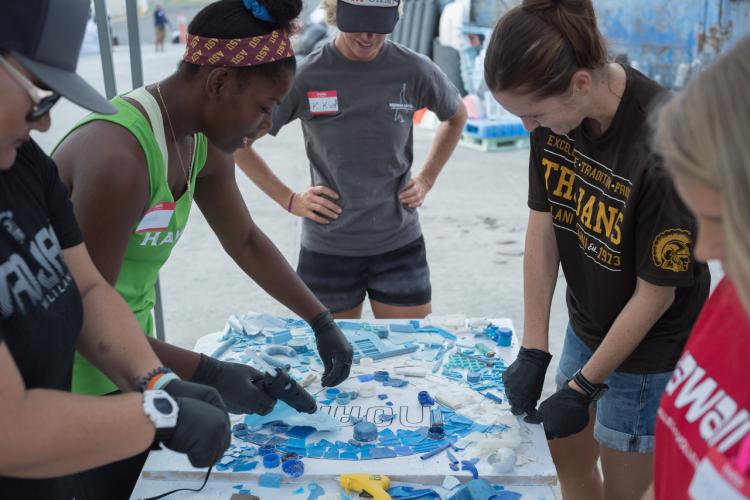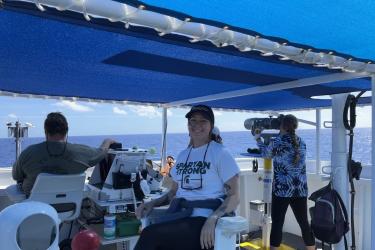We are so grateful for such a successful marine debris mission in the Northwestern Hawaiian Islands! We collected plastic buoys, foam buoys, plastic nets, oyster spacers, tires, pallets, plastic utensils, bowls, lighters, bottle caps, laundry baskets, plastic toys, shoes, beverage and other plastic bottles and jugs, as well as an abundance of plastic fragments—and brought it all back to Honolulu to repurpose and recycle. The mission would not have been possible without everyone’s support, from the administration, to the funders, to the students who have helped us along this journey every step of the way. What better way to express our gratitude than through outreach events?
As soon as we returned, our team started sorting the debris we collected and staging it at the NOAA Inouye Regional Center in Honolulu for outreach events. Congratulations to the students from Mililani High School, who came up with more than 100 questions and solutions relating to marine debris—they won a field trip to visit us and all the debris! Of course, a great mahalo (thank you) to the other local schools that participated in the contest and the students and teachers that took time in their busy schedules to share our passions and concerns about marine debris. We hope our time with you was valuable and inspiring.
Our first outreach event with Mililani High School was held on November 2, 2018. To introduce this event, our fearless leader, Kevin O’Brien, gave a short introduction to the marine debris project and the scope of our work. From that point on, we split the students into two groups: 1) at an arts and crafts station and 2) sorting giant bags of marine debris that we collected on our mission.

At the arts and crafts station, the students had the option to create a mosaic out of small plastics or create decorations and holiday ornaments out of small plastic fishing floats. The first group chose to create a mosaic of their school symbol, while the second group chose to dive into the small, hard floats pile and paint new works of art.

At the marine debris sorting station, the students were very quick and enthusiastic. They immediately appointed data managers to record the debris piles, while the rest of the groups ambitiously began sorting through and organizing the debris. They were so fast and efficient that they ended up sorting through three massive piles of debris in just 45 minutes!

Students tour the NOAA Ship Sette (Photo: NOAA Fisheries/Steven Gnam).
After the station cycles were completed, they received an in-depth tour of the IRC facility, as well as a tour of the NOAA Ship Oscar Elton Sette. The students wanted the tour of the ship so badly that they willingly skipped lunch for it! By the end of the day, students were asking about volunteer opportunities with NOAA and the teachers wanted to take home debris for future lessons.
The second outreach event centered on a media event, as well as the involvement of another group of students. Similar arts and crafts and sorting stations were set up with the hopes of reaching a wider range of viewers from all over the state. We hope that we have been able to inspire all of you to REFUSE, REDUCE, REUSE, and RECYCLE, as a way to mitigate plastics that end up in our oceans, because marine debris is everyone’s problem!

Meet the Blogger

Rebecca Weible is currently earning a master's degree in Zoology from the University of Hawai‘i at Mānoa, but she is taking a break from studying to work with the marine debris team on this incredibly unique and important mission. She loves diving, kayaking, hiking, and surfing and wants—more than anything else—to protect the natural environments that make these activities so rewarding.
Follow us
Check out photos and updates from the mission on our Story Map.
Partners
NOAA Fisheries marine debris project in the Pacific Islands region is supported by NOAA (Pacific Islands Fisheries Science Center, Pacific Islands Regional Office, Marine Debris Program, National Marine Sanctuaries, and the Damage Assessment Remediation and Restoration Program) in partnership with the University of Hawaii's Joint Institute for Marine and Atmospheric Research, National Fish and Wildlife Foundation, U.S. Fish and Wildlife Service, Midway Atoll National Wildlife Refuge, the State of Hawaii’s Department of Land and Natural Resources, and the Papahānaumokuākea Marine National Monument.


